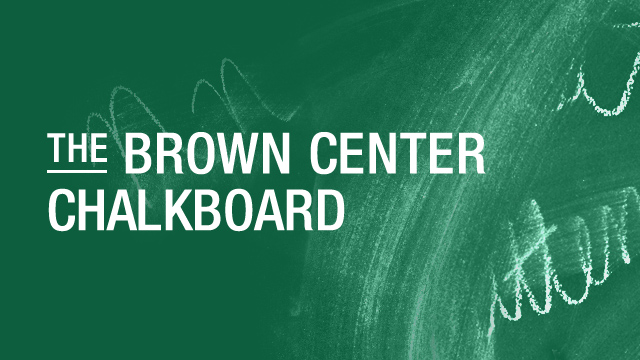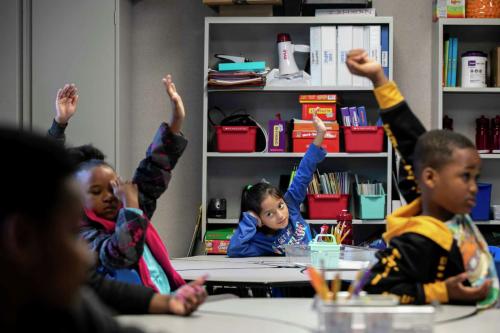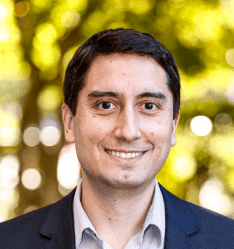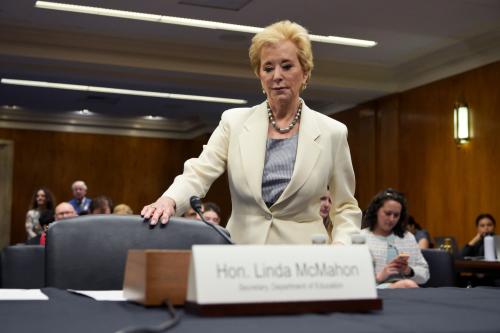The Educational Choice for Children Act (ECCA) continues to move, quietly, towards becoming one of America’s costliest, most significant federal education programs. Now part of the One Big Beautiful Bill Act, ECCA would create a federal tax-credit scholarship program that’s unprecedented in scope and scale. It has flown under the radar, though, and remains confusing to many observers.
Recently, a colleague and I showed how ECCA is poised to redistribute funds from poor and rural communities to wealthy and non-rural communities. A study from the Urban Institute drew similar conclusions. Since those pieces were published, ECCA—then a standalone bill—has passed through the House of Representatives and now moves to the Senate. ECCA’s fate remains uncertain, which makes this as good a time as any to examine its potential implications.
How would ECCA work?
ECCA’s stealthiness is partly due to the confusing nature of tax-credit scholarship programs. These programs move money in circuitous ways to avoid the legal and political hurdles that confront vouchers. Tax-credit scholarship programs like ECCA aren’t quite private school voucher programs, but they’re first cousins.
In a voucher program, a government gives money (a voucher) to a family, which the family can use to pay for private school tuition or other approved expenses. With a tax-credit scholarship, it’s not that simple. Governments offer tax credits to individuals and/or corporations that donate to scholarship-granting organizations (SGOs). These SGOs then distribute funds (“scholarships”) to families.
The U.S. already has 22 tax-credit scholarship programs, but they’re relatively modest, state-level programs. ECCA is different. ECCA would create a massive, federal tax-credit scholarship program, operating across all 50 states, with a current price tag of about $5 billion in the first year (down from $10 billion in the bill’s earlier draft). It offers an extremely generous tax credit. Individuals get a full, 1:1 tax credit (not just a deduction) for their contributions, which fully offsets their contributions. In other words, these “donors” don’t actually give up any money—hence the quotation marks. On top of that, ECCA allows individuals to donate marketable securities (e.g., stocks) rather than cash. This provides an avenue to treat ECCA as a tax shelter and avoid paying capital gains taxes. More on that in a moment.
Most students would be eligible for a scholarship, with the exception of those from households that earn more than three times their area’s median gross income. (More on that in a moment, too.) The list of qualified expenses covers everything from private school tuition to online educational materials.
Rather than go through all of the bill’s details, let’s take a look at a scenario that illuminates what this program could do. Remarkably, this scenario appears—to my eye, at least—fully compliant with the House bill (even if the characters are a bit overstated).
A hypothetical scenario to illustrate some of ECCA’s risks
A ‘donor’ who benefits from ECCA’s tax shelter
Let’s imagine a billionaire, Billy, who couldn’t care less about K-12 education but cares a whole lot about his own wealth. Billy hears about ECCA from an acquaintance who tells him about how much money Billy could save by “donating” to an SGO. Billy’s adjusted gross income (AGI) was $20 million last year. That means, according to ECCA, that he’s eligible to donate $2 million to an SGO this year (10% of his AGI).
Let’s walk through the math for Billy’s donation. Billy is looking to give $2 million in stock shares to an SGO. He bought these shares a few years ago for $1 million and then they doubled in value. That means that Billy’s earnings are subject to long-term capital gains tax if he sells the stock. With his AGI, that would be 23.8% in federal taxes plus another 4.7% or so in state taxes (depending on where he lives). In other words, if Billy sold the stocks today and kept the funds for himself, he’d owe about $285,000 in combined federal and state taxes on his $1 million in earnings (28.5% of $1 million).
By donating the $2 million in stock to an SGO, not only does Billy get his entire $2 million back as a tax credit; he also dodges those capital gains taxes. He’s a billionaire who is $285,000 wealthier for having made this supposed donation. (For a detailed illustration of how this works—and some nice figures—I’d recommend this piece from the Institute on Taxation and Economic Policy.)
A scholarship-granting organization with extraordinary leeway in how to direct ECCA funds
Now, let’s get back to that SGO. Billy’s acquaintance, Fred, lives in the same town as Billy, which is one of the wealthiest areas in the United States. In fact, Fred set up the SGO, looking to capture ECCA funds within their shared community—and, just maybe, for himself. Like Billy, Fred doesn’t particularly care about K-12 education. He does have a penchant for fraud, though, along with a strong distaste for Republicans.
It might seem that Fred’s SGO couldn’t distribute funds to families in their ultra-wealthy area, since ECCA has income restrictions for scholarship recipients. That’s not the case. ECCA restricts eligibility to households with an income not greater than 300% of their area’s median income. In Fred and Billy’s town, with its soaring household incomes, even multimillionaire families with $500,000 in annual income are eligible. In more modest (and rural) areas, the cutoffs aren’t nearly so high.
So, Fred is looking to give scholarship money to some wealthy families in his hometown. Notably, ECCA doesn’t limit the amount of money that he can give to any one recipient. ECCA just requires that he provide scholarships to at least two students—who, between them, attend at least two different schools—and that he not earmark the funds for any particular student. Fred offers students $100,000 apiece for supplemental tutoring. That might seem like a lot, but, hey, this is high-end tutoring.
A vendor with little oversight or accountability
In fact, Fred stipulates that the funds must be spent at a new tutoring shop, High-End Tutoring, just created by his buddy, a former teacher. ECCA seems to allow that. ECCA also allows Fred to take a nice cut for himself for running the SGO: 10% of the SGO’s total receipts.
No one really knows the arrangement that Fred and his tutoring friend have, if they have one, because there are hardly any transparency or accountability provisions in ECCA (aside from a requirement to obtain annual financial and compliance audits). We also won’t know if High-End Tutoring provides any educational value, because that’s not part of ECCA either. ECCA’s proponents have claimed there’s accountability to the SGO donors, who want to see their generous donations being put to good use. Billy, though, is enjoying his $285,000 money grab and content to leave Fred alone until it’s time for next year’s donation.
An invitation to discriminate—and an attempt to keep local and state governments from intervening
Fred does have one requirement of his own for High-End Tutoring that he doesn’t need to hide. High-End Tutoring isn’t going to serve any children of Republican parents. All students must complete an attestation form—stating that they and their parents are progressive—before receiving any tutoring services from this publicly funded vendor. Across town, another SGO leader is formally excluding LGBTQ+ children and children of LGBTQ+ parents from their pool of scholarship recipients.
ECCA, in its current form, seems to allow all of this, as objectionable as it may seem. And it’s not just an issue with SGOs funding tutoring companies or other supplemental services. Similar issues could arise with private schools, especially in states without strong anti-discrimination protections.
From hypotheticals to reality
The scenario above might seem ridiculous or caricatured, and to some extent it probably is. But the point is, it’s allowable under the proposed legislation, and we should be realistic about how much fraud, waste, and bad behavior a program like ECCA would invite.
Should we not expect wealthy stockowners to jump at the opportunity to exploit ECCA’s tax shelter? Is it unreasonable to think that many of these wealthy donors will look to benefit their own communities through their donations? Have we not seen bad actors creep in when governments offer large checks with hardly any accountability or strings attached?
This isn’t some tiny, insignificant program either. This is a $5 billion federal program that, because of a “high-use calendar year” provision in ECCA, is almost certain to grow 5% annually. In fact, the cost is likely to be considerably higher than that due to the foregone capital gains tax revenue. That’s not quite the size of the behemoth federal K-12 programs—Title I ($18.4 billion in FY 2024) and IDEA ($15.5 billion)—but it’s not all that far off.
And let’s be clear about cost, because ECCA certainly isn’t paid for by the contributions of generous donors. Tax credits are would-be revenue that the IRS is no longer collecting. That money is coming from somewhere else in the budget, whether it’s cuts in education spending, cuts to Medicaid or other social services, tax hikes, or increased debt.
This bill would introduce the most significant and costliest new federal education program in decades. It has virtually no quality-control measures, transparency provisions, protections against discrimination, or evidence to suggest that it’s likely to improve educational outcomes. It’s very likely to redirect funds from poor (and rural) areas to wealthy areas.
And, in its current form, ECCA leaves a whole lot of room for waste, fraud, and abuse.
The Brookings Institution is committed to quality, independence, and impact.
We are supported by a diverse array of funders. In line with our values and policies, each Brookings publication represents the sole views of its author(s).






Commentary
The Educational Choice for Children Act opens the door to waste, fraud, and abuse
May 28, 2025